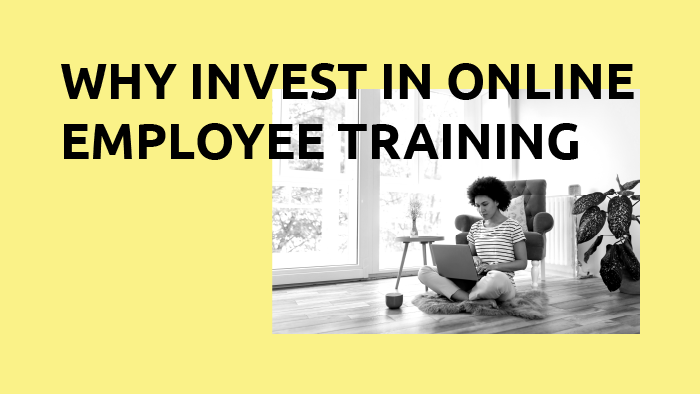Pricing for online training is important to understand if you want to ensure your money is invested wisely and that it will pay you back with positive ROI. That’s why we’ve written this two-part blog series – to provide you with deep insight into the often murky space of pricing for online learning.
With a wide variety of providers and pricing structures out there, doing research into this question of “How much will online training cost us?” can be quite the headache. We get it! And we’re hoping that both part one and part two of this blog series can make your search for the right provider less of a burden.
If you haven’t had a chance to read part one yet, make sure to check it out! It will give you a strong understanding of the options available for online learning and how your training program would look, depending on the options you choose.
Click here to read part one of this pricing series!
For part two, we’ve done a lot of research into what’s available to you for online employee learning and pulled a whole bunch of numbers together. These estimates and examples should help guide your expectations for what pricing can look like with different options and goals. To start off, we’ll look at pricing structures for different aspects of online training solutions, then toward the end we’ll give you examples of what an investment in online learning could look like based on your goals for training your employees.
These estimates and examples should help guide your expectations for what pricing can look like with different options and goals for online employee training.
If you’re looking through these example costs and they’re not lining up with your expectations, consider how your company can optimize total training expenditures by utilizing online technology in place of some more expensive methods. Training Magazine reports that over the past couple years, companies have spent an average between $1000 and $1300 per employee annually.
You may not be able to deliver all training online, but as you assess pricing for online technology, be sure you account for ways it could help reduce other training and development costs.
Here’s a breakdown of what we’ll look at in part two (click to jump to a section):
- Pricing Structures for Online Learning Platforms
- Paying by Functionality
- Paying by Registered Learners
- Paying by Active Learners
- Contract Length
- Platform-Only Price Estimates
- Pricing Estimates for Online Learning Content
- Pricing for Individual Courses
- Pricing for Course Bundles or Topic-Specific Libraries
- Pricing for Comprehensive Content Libraries
- Combining Platform and Content Pricing + Examples
- Service and Support Costs
- Implementation
- Technical Support
- Strategic Support
- Professional Services and Add-Ons
- Cost Estimations for Different Training Objectives
- Objective #1: Active Skill Development for All Employees
- Objective #2: Exploratory Learning for All Employees
- Objective #3: Compliance Training for Some Employees
- Objective #4: Training for Managers Only
- Objective #5: All of the Above
- Getting the Budget You Need for Online Learning
Pricing Structures for Online Learning Platforms
One of the reasons it can be convoluted to compare pricing among different providers is that they don’t all use the same pricing structure. Luckily, when it comes to online platforms, there are only a handful of ways to structure pricing, so let’s take a look at each of those.
Paying by Functionality
This is going to look either like a tier system or a standard platform with the ability to add on various features. So for example, you may see a platform with three tiers, with each higher tier adding accessibility to more complex functionality. Another structure could be offering one level of the platform, with add-on features that can be purchased individually.
Paying based on platform functionality may sometimes be a flat fee for unlimited learners, so your rate stays the same if you add or remove learners from the system. That is somewhat rare, though. Typically, this pricing structure is paired with another factor based on the number of learners. So, you would first choose the level of functionality you want, then your actual rate would depend on your learner count, which we’ll look at next.
Paying by Registered Learners
Platform pricing is often based on the number of learners you’ll have, in addition to the functionality you’re looking for. What differs among providers is how they define “number of learners.”
Paying by registered (or enrolled) learners means you can add all the employees you want in the system, and they’ll each have their own credentials with unlimited access to log in and view content. This option makes it easy to budget what you’re spending over a long period, and promotes ongoing learning without worrying about paying more for more utilization.
Compared to paying by active learners, this is going to be a more cost-efficient option when you’re looking to create learning equity and provide continual opportunities for employees to improve their skills.
Paying by Active Learners
Active learner pricing can be a little trickier to keep track of, but if you’re only looking for infrequent or short periods of training access for certain employees, then this option may end up being more cost-efficient.
It’s usually billed monthly and may be based on how many learners either logged into the system, or how many learners engaged with content. “Active” can be defined differently among providers, so be sure you understand exactly what they mean by it.
This is typically on a tier system, so you wouldn’t be paying for the exact number of learners who used the system. For example, if the tiers were 100, 500, and 1000, and you had 386 learners use the system, you would pay based on the price for the 500-learner tier.
This pricing structure makes it less likely that you’ll pay for employees who are registered but aren’t using the system. However, it can be harder to budget for and does not encourage employees to utilize the learning available to them, which is the basis for success of any training program.
Contract Length
While pricing is typically quoted at a per learner per year rate and billed on an annual basis, the overall cost can also be affected by the length of contract you choose. Three-year contracts are standard for learning management systems since it takes time for training programs to really get into a groove with an LMS.
Opting for a one-year contract may be possible, but the per learner rates will be higher, and often administrators find that after a year they’ve just scratched the surface with what they could be getting out of the system. Since it’s likely you’ll need two or three years to really get things rolling with the platform and your program, going with the lower price per learner for the three-year contract often makes the most financial sense.
Platform-Only Price Estimates
The chart below aggregates pricing from many different platform-only providers, to give you an idea of what you might encounter (Potential Range), along with what’s most common to find from the majority of providers (Median Range). Some providers will quote pricing per month and some will be per year, but for those who offer both options, there’s typically a discount if you pay annually instead of monthly. For the sake of comparing pricing across providers, we’ve calculated everything as annual rates.
Keep in mind (with all of the examples throughout this post) that prices almost always have an inverse relationship with the number of learners. The less learners you have, the higher the cost per learner, and vice versa.
This chart encompasses both registered and active learner pricing, and it represents estimates for an “empty” platform – no content included. We’ll look at estimates for content in the next section!
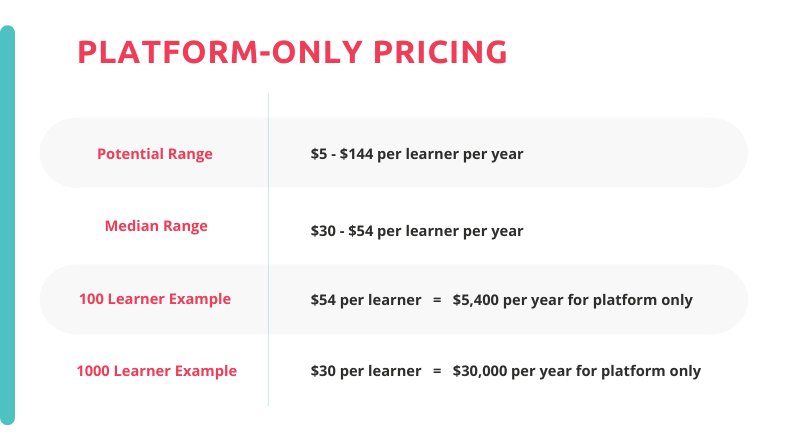
“Potential Range” refers to the broad spectrum of platform pricing you may find. “Median Range” is nearer to where the majority of providers would fall.
A Note About Open-Source Learning Management Systems
An open-source LMS is an alternative option to a proprietary system, where any organization can get access to the source code and customize it however they want to, without paying a license fee. This can be an attractive option if your company is looking for unlimited ways to customize your LMS, and has the tech talent ready to dedicate time to do it.
Just be aware that no system is truly free – open-source LMS’s will cost you hosting and storage fees, plus continual time from highly skilled (and expensive) IT professionals to customize and maintain the system. In reality, they can often end up costing more than paying a license fee for a proprietary platform. If you’re considering this option for a platform, learn more in this Elearning Industry article.
Pricing Estimates for Online Learning Content
In part one of this blog series, we talked about a few options for obtaining content, based on the amount of courses you’re needing. Pricing can look wildly different when you’re shopping for individual courses, versus a small set of courses or a topic-specific library, versus a comprehensive/full content library.
If you’re not sure which of these options would best help you reach your goals, be sure to check out the sections where we talk about content in part one.
Pricing for Individual Courses
Cost ranges for licensing individual courses vary quite a bit based on the topic you’re looking for. If they’re general compliance courses, they’re typically easier to produce, so pricing is on the lower end. Once you get into more advanced skill-building (and any courses that qualify the learner for a certification), costs go up dramatically.
In the chart below, we’ve separated general compliance from more advanced skill development for this reason. Although bulk pricing is usually available when you have a larger number of learners all taking the same course, keep in mind that if you have learners taking different courses from different providers, you won’t get the benefit of bulk discounts.
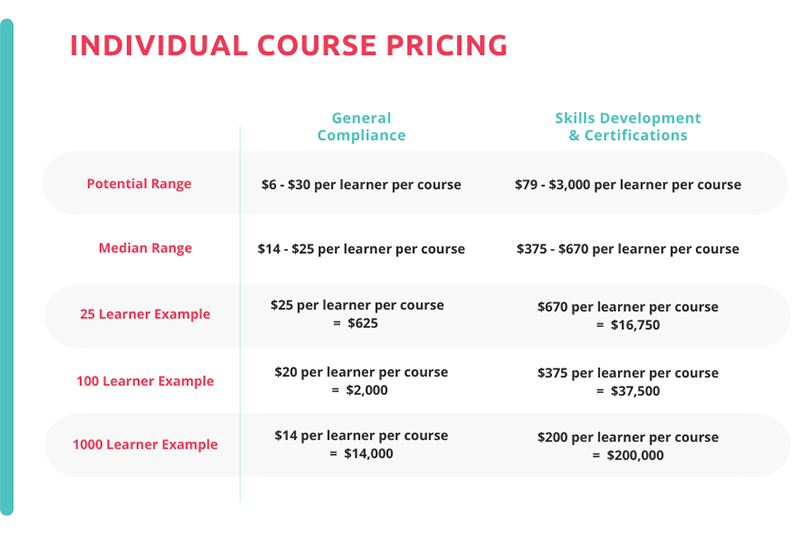
“Potential Range” refers to the broad spectrum of individual course pricing you may find. “Median Range” is nearer to where the majority of providers would fall.
Pricing for Course Bundles or Topic-Specific Libraries
With this option, there will also be big differences in pricing based on the topic you’re looking for. Topics that are more fundamental or apply to a wide variety of job roles, such as soft skills and compliance, will generally be on the lower end of the pricing spectrum.
Once you’re looking for more advanced topics, such as IT or leadership training, you’ll be looking at higher prices.
We did not provide a median range for this chart since it varies so much based on topics, and instead gave examples of what kind of training could be associated with each example.
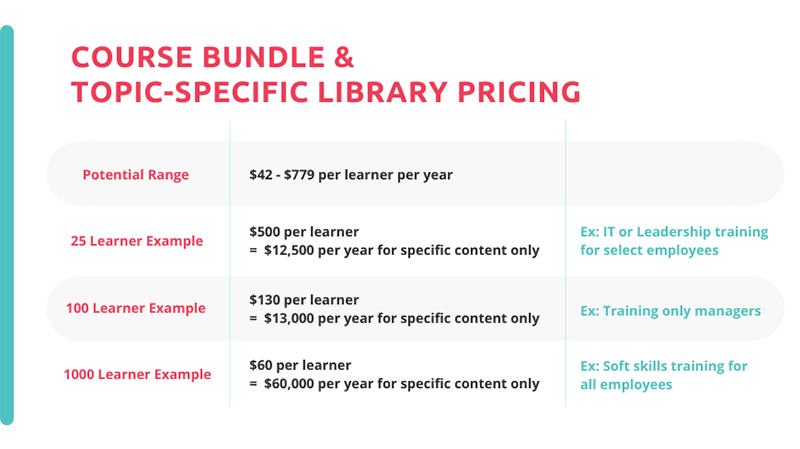
Pricing for Comprehensive Content Libraries
This is the content option where you’re going to get the most bang for your buck. Large libraries not only get you the best cost per course, they significantly increase the opportunities you have to deliver training and use L&D to overcome business challenges.
In general, when we refer to a content bundle or a topic-specific library, we’re talking roughly 200 courses or less. Maybe that sounds like plenty to you, and it might be if your training program is still new or specific to a group of employees. However, if you need a more well-rounded program or want to foster a culture of learning, you’ll find that small amount of courses doesn’t cut it when it’s divided up among all the topics and specific skills needed across your organization.
In contrast, a full content library typically has anywhere from 1,000 to 10,000+ courses. If you’re evaluating options between a small library and a comprehensive one, you may find that the rates per learner are only slightly higher on the larger library, meaning the difference between giving your employees access to a couple hundred courses versus several thousand might not be as big as you think.
Here are some estimations and examples based on what we’ve found for licensing comprehensive content libraries.
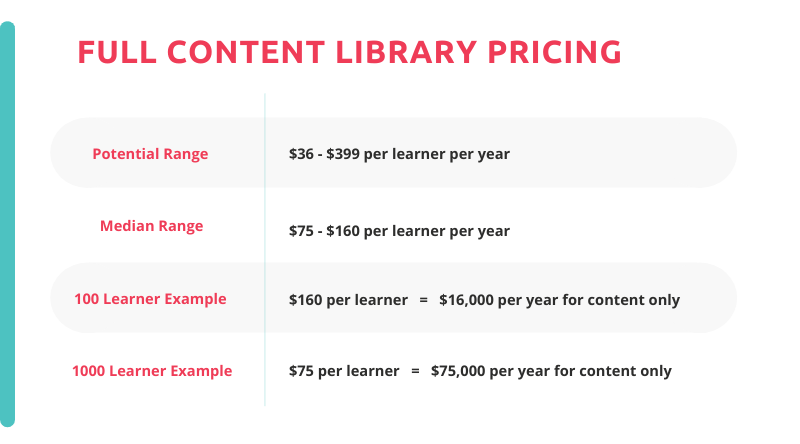
“Potential Range” refers to the broad spectrum of content library pricing you may find. “Median Range” is nearer to where the majority of providers would fall.
Combining Platform and Content Pricing
In the previous section, we looked at pricing estimates for content only – not including a platform to manage, track, and report on that content. The section before that was for platform-only pricing. Now let’s look at combining the two!
When you’re interested in a full content library, you have the option either to license it separately from your learning platform or to license a platform and content library together from the same provider.
This combination option typically comes at a lower cost than licensing separately – both with the upfront costs, and also the amount of time it saves you or your staff from managing third-party content in your platform on an ongoing basis.
Here are some estimated costs for choosing a combined platform + content option as your online learning solution:
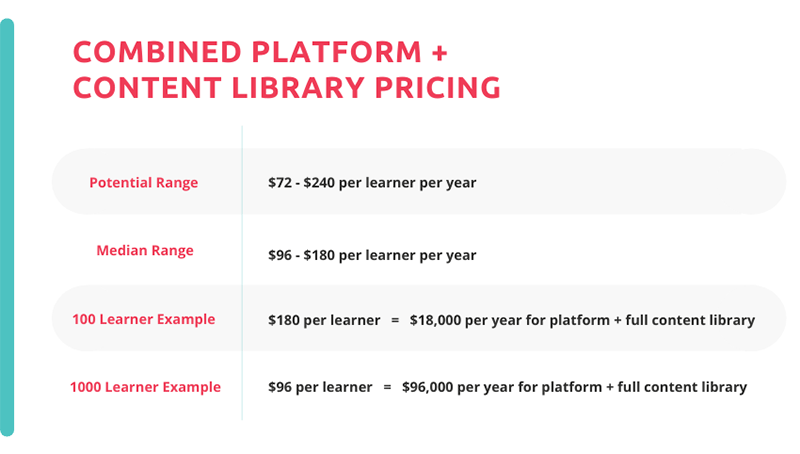
“Potential Range” refers to the broad spectrum of platform + library pricing you may find. “Median Range” is nearer to where the majority of providers would fall.
When you compare these total costs with what you might pay for a separate platform and content, it becomes clear that combining the two is often more cost-effective.
Using the 100-learner example, if you license a platform at $54 per learner per year, you’ll pay $5,400 for the platform. Plus, licensing a full content library at $160 per learner per year brings you to $21,400. Going with a combined platform and content library, your cost could be closer to $18,000, saving you a few thousand dollars right out of the gate for the same system.
We’ve looked at a lot of different charts so far, so to give you a clearer comparison of these options, here are a couple charts with example costs based on 100 learners and 1000 learners. Keep in mind, these are only examples of pricing to give you a general idea of what to expect when evaluating different providers – the actual quotes you get will likely look different, depending on your organization’s specific needs.
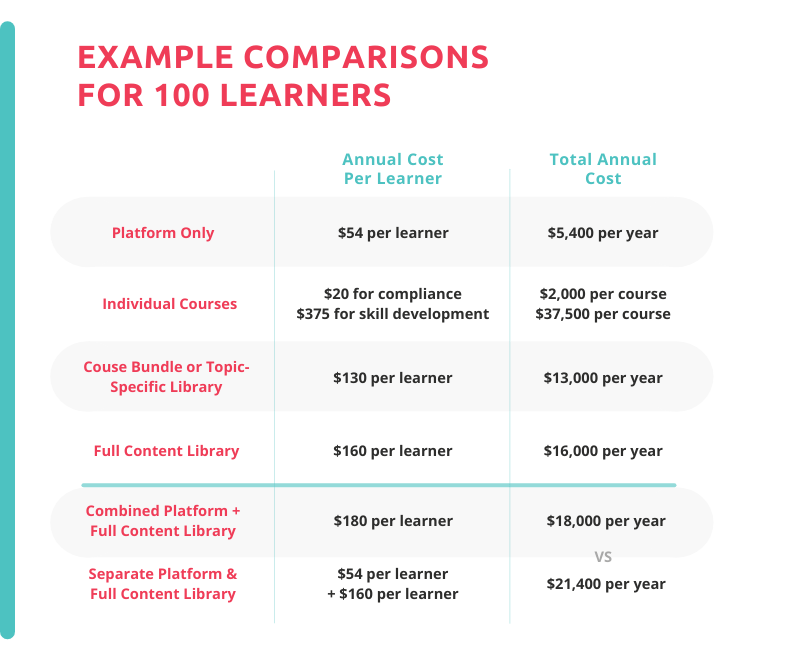
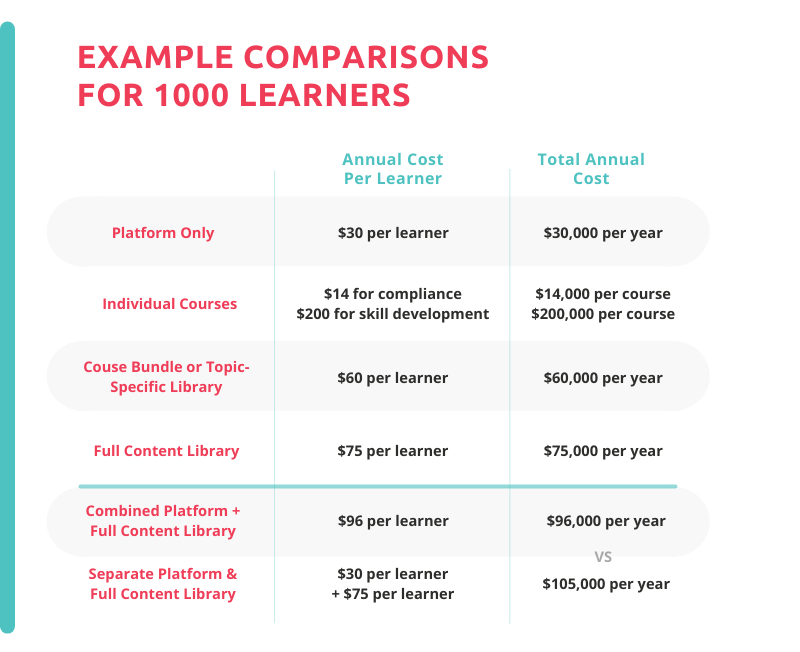
Service and Support Costs
The service and support you receive from an online learning provider is absolutely just as important as their product offering. We recommend you look for a provider who will offer you a true partnership, where you know you can count on them for any technical needs that come up, along with strategic support and continual training to ensure you’re getting the most out of their products.
We talk a lot about what a partnership looks like in part one, so be sure to check that out and learn why this is such an important element for your online training program to be successful.
When you’re evaluating providers, it’s critical to understand what is and is not included in the quote they give you. Some providers charge extra for nearly all services, including technical support over the phone, while others will give you a high level of overall support at no extra cost.
At BizLibrary, we believe strongly in the importance of great service and support, which is why many of these costs are baked into our initial pricing. We want clients to be able to rely on us to support their full training program, so we don’t bill extra to guide them through implementation, or to provide technical and strategic support.
Implementation
This is where you’ll get your new technology up and running, and your administrators will be trained on how to use the product. Before you sign a contract, be sure to find out whether implementation and admin training is included or if it will cost you extra. For some systems, this can be priced anywhere from a couple thousand dollars to $10,000 or more.
Since you know you’ll need this service in order to have a successful start with your online learning technology, make sure you’ve factored this into your total contract price.
See how implementation works at BizLibrary!

Technical Support
Being able to easily get in touch with your provider for technical assistance should be a given, but some providers price it as an extra cost or upgrade. Sometimes you’ll get email and/or online chat support included but will have to pay extra for help over the phone. If full technical support isn’t included in your quote, make sure you know how much more that would be to add on.
You definitely don’t want to purchase a platform or a content library and then find out you have to pay extra any time you need help.
Strategic Support
This is a big one, but there are many providers who don’t offer this type of ongoing service to clients. Strategic support is where the magic happens with your training program – and not just the online part of it. Some providers (such as BizLibrary) recognize that your success is their success, so they give every client access to a Client Success Manager who will work with you one-on-one for strategies and practical ideas to use in your total training program.
If you’re serious about seeing ROI for the online learning solution you purchase (a.k.a. turning that cost into an investment), make this a priority area for evaluating providers, and make sure it won’t cost you an arm and a leg on top of what you’re paying for their product.
For some providers, this will be included in your quote and contract price, but for many it’s considered an upgrade and will be tacked onto your bill.
Professional Services and Add-Ons
There are some services that are considered more premium types of support and are widely considered upgrades, add-on services, or included only in the highest-priced tiers.
These often include things like:
- Creating custom content
- SAML or SKIM authentication
- User feeds
- Learner certifications
- Localization services
- Data migration
- Integrations with other platforms
If there’s a particular service you’re already aware that you’ll need, make sure that’s included in your quote. Determining your professional service needs may involve talking with your IT team to ensure a technology provider can meet their expectations.
The takeaway here is to ensure you include evaluation of services and support in your pricing comparisons among providers. As we said in part one, a strong partnership is the foundation of your training program’s success – don’t overlook it!
Cost Estimations for Different Training Objectives
Alright, are you ready to see how these cost estimations compare to your goals for your training program? In this section, we’re going to look at five different objectives for training and development, and lay out some options with example costs for fulfilling those goals.
Again, these are just examples, so actual quotes and costs will vary based on your organization’s needs and the providers you’re evaluating. Also, if you need to add on any professional services, keep in mind that would be in addition to the totals in these examples.
Objective #1 – Active Skill Development for All Employees
With this objective, you’re looking to provide ongoing upskilling and reskilling across your organization. Whether it’s executive leaders, middle managers, frontline supervisors, or individual contributors, you see the need to provide personalized learning to help employees build and evolve their skills. By having development plans mapped out for each employee, you can fuel continual improvement of their performance and keep them engaged in their roles.
Here are two options for using online learning solutions to fulfill this objective:
Option 1
License a platform that includes the ability to map roles, skills, and content, so you can create learning paths to personalize each employee’s training. License a full content library separately and take the time to manually map skills to content yourself.
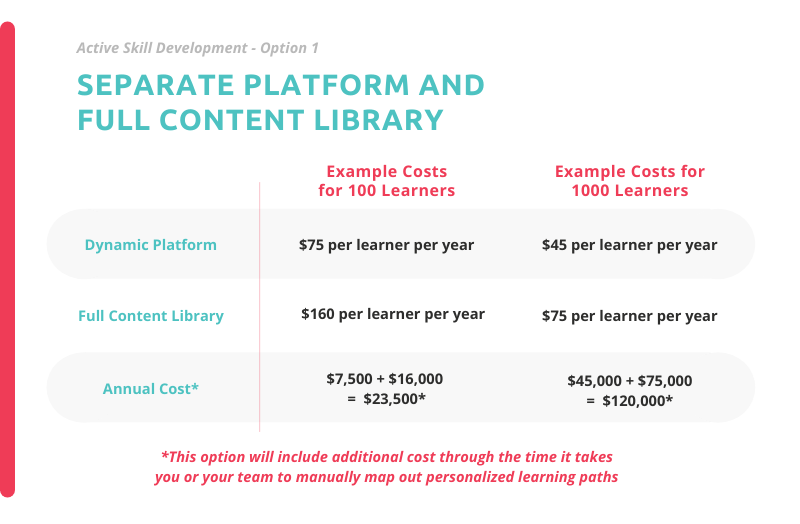
Option 2
License a platform that provides access to pre-mapped roles, skills, and a content library all in one package, so all you have to do is assign learners to roles and you’re off to the races developing employees’ skills.
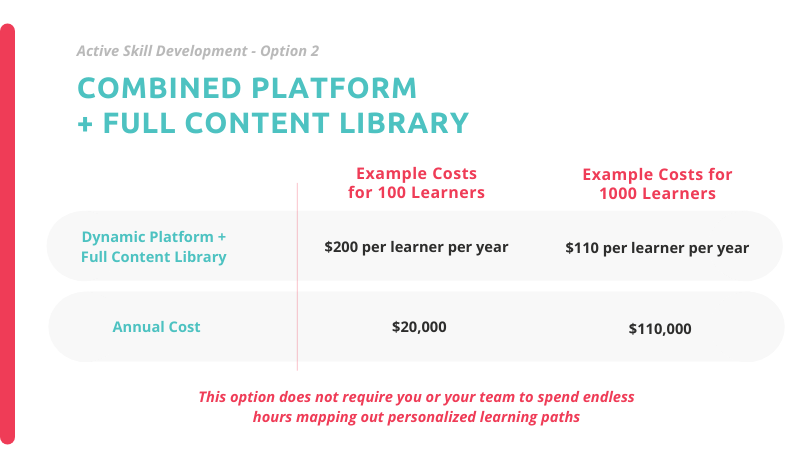
This second option might sound too good to be true, since this kind of solution is just now being developed and released to the learning technology market.
At BizLibrary, we’ve recognized this need for personalized skill development that removes the barrier of time and manual labor from L&D professionals, and we’ve doing something about it.
Objective #2 – Exploratory Learning for All Employees
Since employees today need opportunities for learning and career growth to stay engaged in their work, many organizations are looking for simple ways to provide high-quality content that employees can explore and use for self-directed learning.
Technology-wise, there’s really only one option to fulfill this objective. You’ll want to license a platform that makes it easy for employees to explore a comprehensive content library with search and filtering, receive content recommendations, share content with others, and overall take charge of their own learning journey.
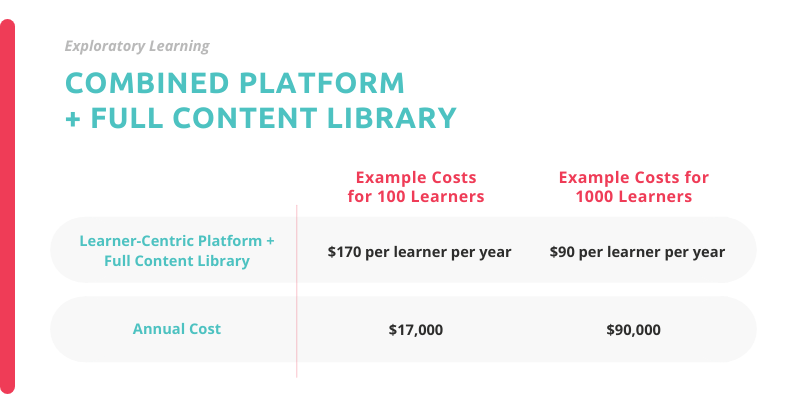
Objective #3 – Compliance Training for Some Employees
If your main training objective is simply providing online compliance training to certain employees, there are a couple ways you could go with obtaining content. The platform you choose doesn’t need a lot of fancy features – your main focus would be capabilities for easily assigning, tracking, and reporting on course completions.
Option 1
License a basic platform that can assign and track training, and license compliance courses individually to import into the platform. This example includes five general courses.
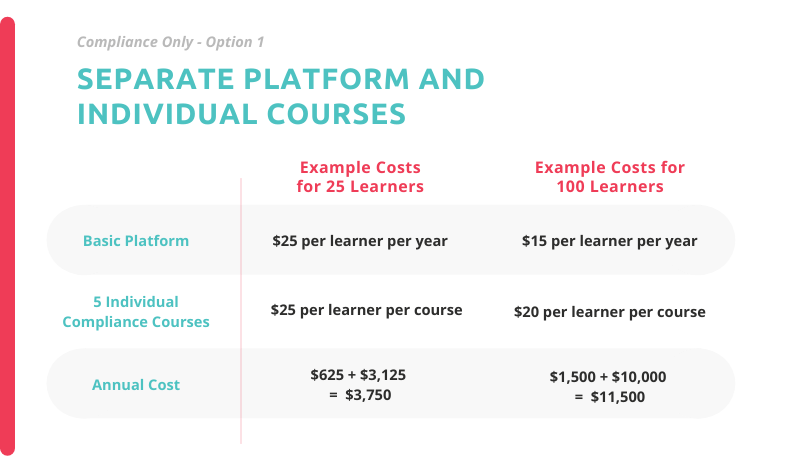
Option 2
License a small library of compliance content that includes a platform with easy-to-use functionality for assigning and tracking training. This example includes 50 courses within a content library, with both general and more targeted compliance topics.
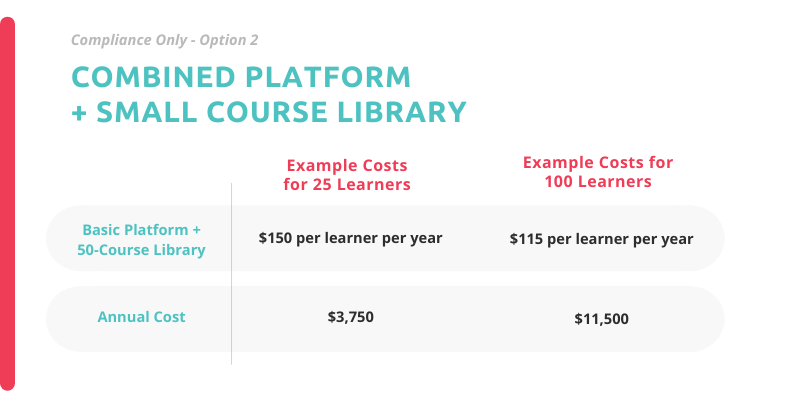
You may notice that the total costs for both examples are the same, even though one only includes five courses and the other includes 50. That’s because the cost-per-course can significantly increase when courses are licensed individually. At first glance, it may seem less expensive to only license a few specific courses you need, but you may find when evaluating small content libraries that you can access a lot more content for approximately the same cost.
Objective #4 – Training for Managers Only
This is often an objective for organizations who are just getting a training program off the ground and want to try it out on a select group of employees before they invest in training for their entire workforce. Manager training is great for pilot programs because their development can have a big impact on their teams’ overall performance.
Depending on what you’re hoping to accomplish with providing training to managers, there are a couple options you could look into.
Option 1
License a basic platform that can assign and track training, and license a course bundle for manager training content. In this example, you’d get 20 courses in the bundle.
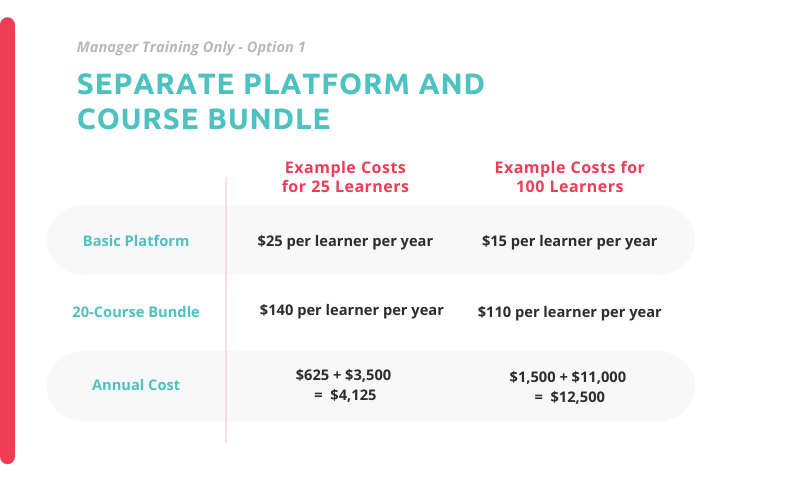
Option 2
License a platform with features to get managers more engaged in learning (such as content recommendations), with a small library of leadership and management training content included. In this example, the library would give them access to 200 courses.
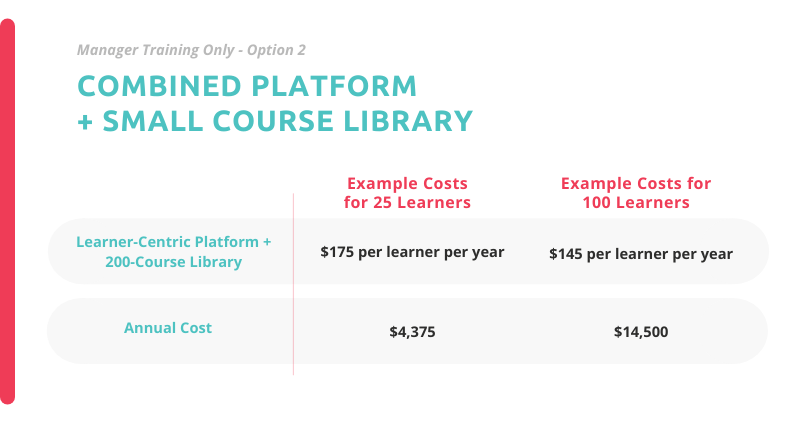
Objective #5 – All of the Above
You might be looking through the previous four examples and thinking, “But what if we want to have all these objectives for our training program?” To that, we say, “Awesome!” You obviously recognize the many ways L&D is valuable to your business and organizational growth.
Here’s what you’ll need from your online learning solutions when you want to offer manager training, compliance training, exploratory learning, and active skill development for your full workforce:
- A platform that allows for personalized training through roles, skills, and content all mapped together
- Platform features that make it easy for employees to find and share learning content that interests them
- Easy-to-use administrative functions for assigning, tracking, and reporting on training
- A comprehensive library full of engaging content for any role
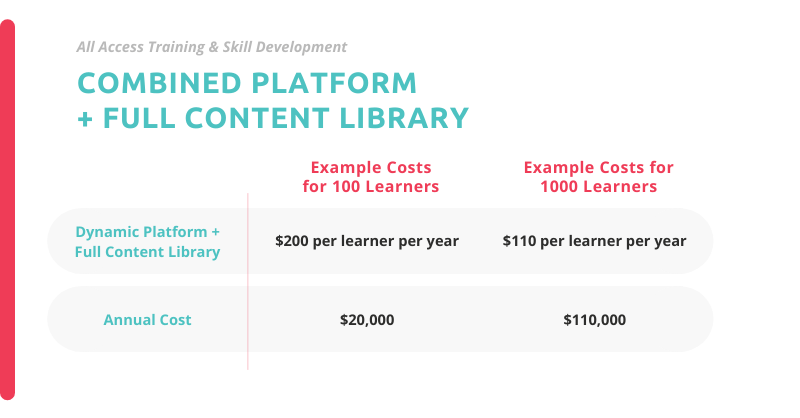
Now you may be wondering… does this kind of learning technology even exist?
We’re glad you asked. As we noted in Objective #1, there are very few providers who offer streamlined technology for skill development, and most of those don’t have content pre-mapped to skills and job roles for you, which would be a big undertaking for you or your staff to do internally.
That’s why we’ve worked so hard to equip our platform with unique features that make the job of personalizing employee development more streamlined and dynamic, so you can easily deliver relevant learning to employees at scale.
If this sounds interesting to you, be sure to talk with your BizLibrary Account Manager about our platforms capabilities. If you haven’t been in touch with our sales team yet, reach out today to learn how our online employee learning solutions can meet your organization’s specific L&D needs!

Getting the Budget You Need for Online Learning
Congratulations, you’ve gained a whole new understanding of pricing for online training solutions! We hope this two-part blog series has been helpful in your search for the right technology to reach your L&D goals.
If you’ve looked over all these example costs and have no idea how you’re going to make this a budgetary priority, we’re here to help with that, too! Partnering with a training provider who really knows their stuff means this budget item won’t be a sunk cost – it’s an investment that will lead to improvements across your business. Check out this article to learn how investing in training saves money for your organization by addressing costly challenges.

